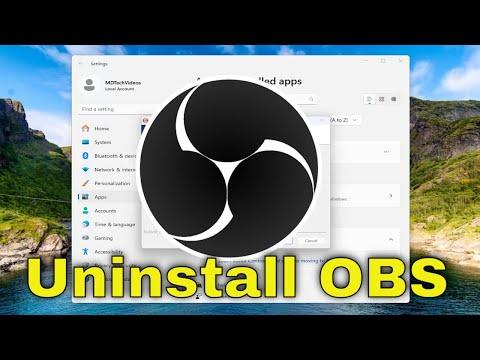It was a routine evening when I first encountered the issue that would soon become my obsession. I was working on a project that required precise streaming and recording, and OBS Studio was my go-to tool for this. Everything was going smoothly until I started experiencing inexplicable glitches. Streams were lagging, recordings were stuttering, and my system performance seemed to deteriorate. After some troubleshooting, I decided it was time to completely uninstall and reinstall OBS Studio to start fresh. Little did I know, the process of removing this program would be more involved than I had anticipated.
Initially, I attempted the standard uninstallation through the Control Panel, hoping it would resolve the issues. I navigated to “Programs and Features,” located OBS Studio in the list, and clicked “Uninstall.” To my surprise, the application disappeared from the list, but remnants of the program remained on my computer. The issues persisted, and it became clear that a simple uninstall wasn’t going to cut it. I needed to dig deeper to ensure that every last trace of OBS Studio was eradicated.
Determined to get it right, I started my search for a more thorough approach. I began by checking the installation directory where OBS Studio was initially installed. I navigated to the “Program Files” folder and found the OBS Studio folder still there. Even though I had uninstalled the program, these files had not been removed. I manually deleted the OBS Studio folder, hoping this would clear out any remaining files.
Next, I turned my attention to the user profile. OBS Studio, like many applications, stores configuration files and settings in the user’s AppData folder. To access this, I opened File Explorer and entered “%appdata%” in the address bar. This took me to the Roaming folder, where I found an OBS Studio folder that I promptly deleted. I also checked the “Local” folder within “AppData” and found another OBS Studio directory, which I deleted as well.
Even after these steps, I remained cautious and decided to delve deeper. I used a powerful search tool to look for any additional residual files related to OBS Studio across my entire system. This was a bit of a needle-in-a-haystack situation, but I meticulously combed through the search results. I found a few stray files in various system directories, which I removed manually. The thought of missed files haunted me, so I ran a few system scans with specialized cleaning software to ensure there were no lingering traces.
With the software removed and the files deleted, I then turned my attention to the registry entries. This was the part I was most wary of, as editing the registry can be risky if not done correctly. I opened the Registry Editor by typing “regedit” in the Run dialog box. Navigating the registry, I searched for entries related to OBS Studio and found a few references in the “HKEY_CURRENT_USER” and “HKEY_LOCAL_MACHINE” sections. After backing up the registry, I carefully deleted these entries, taking care to avoid any unrelated keys.
Feeling a bit relieved, I decided to restart my computer to ensure that all changes had taken effect and that there were no leftover processes or services running. After rebooting, I checked to make sure that OBS Studio was no longer present in the list of installed programs, and the folders I had deleted were indeed gone.
Now that OBS Studio was completely uninstalled, I was ready to reinstall it. I downloaded the latest version of OBS Studio from the official website to ensure I was getting a clean and up-to-date copy. The installation process went smoothly, and I took this opportunity to reconfigure the settings from scratch, which allowed me to avoid any potential carryover issues from my previous installation.
Reflecting on the whole process, I realized that completely uninstalling a program involves more than just using the standard uninstall tool. It requires a comprehensive approach that includes removing leftover files and cleaning up system settings. While it took some time and effort, ensuring that every trace of OBS Studio was removed ultimately led to a smoother reinstallation and a fresh start. This experience taught me the importance of a thorough uninstallation process, especially for software that plays a critical role in my workflow.
In the end, the issue was resolved, and my system performance returned to normal. I felt a sense of accomplishment knowing that I had tackled the problem head-on and resolved it through a meticulous approach. This thorough process not only fixed the immediate issues but also improved my understanding of software management and system maintenance.
